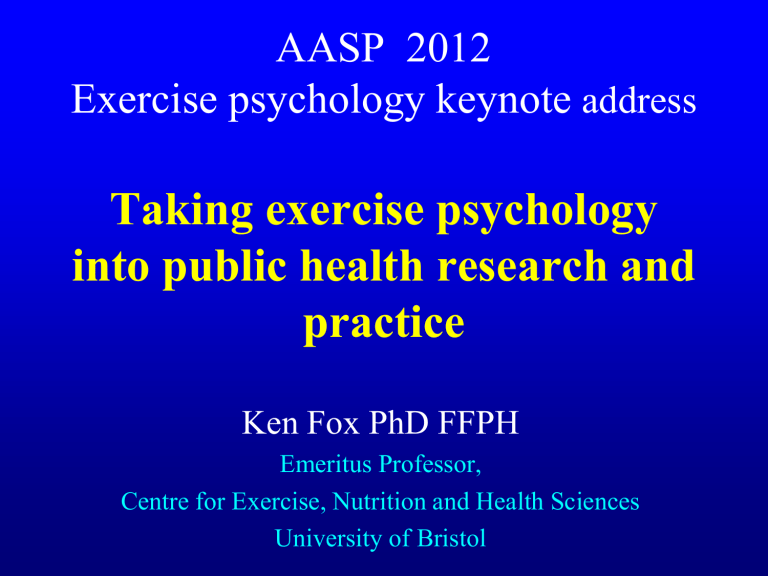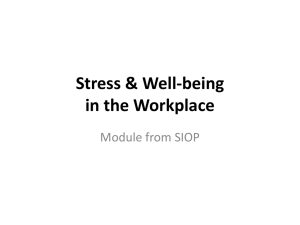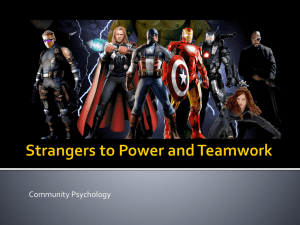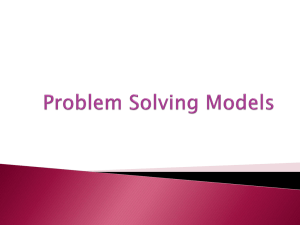Taking exercise psychology into public health research and practice

AASP 2012
Exercise psychology keynote address
Taking exercise psychology into public health research and practice
Ken Fox PhD FFPH
Emeritus Professor,
Centre for Exercise, Nutrition and Health Sciences
University of Bristol
Post Graduate
Centre for Exercise, Nutrition and Health
Sciences,
University of Bristol 1999-present
MSc in Nutrition, Physical
Activity and Public Health
Research into biomedical, psycho-social,and socio-environmental aspects of activity and nutrition
The mediating role of the self
Well-being Self Exercise
The development and preliminary validation of the Physical Self-Perception Profile,
Journal of Sport and Exercise Psychology , 1989
The Physical Self: From Motivation to Well-Being . Human Kinetics, Champaign,IL ,
1997
Presentation outline
• Public health and its development
• Exercise psychology in public health
• Working in the world of public health
• Working in the commercial sector
• Opportunities for exercise psychology
Public health and its development
Earliest public health epidemiology
Problem :
Cholera spreading in London (1853-4)
Thought to spread through ‘bad’ air or miasma
But Dr John Snow suspected something different
Water
Company
Southwark
& Vauxhall
Lambeth
Rest of
London
Death Rates From Cholera
1853-54
Number of
Houses
40,046
26,107
256,423
Deaths From
Cholera
1263
98
1422
Deaths per
10,000 Houses
315
37
59
Original Broad Street with pump
Simple and cheap solution?
:
Remove the handle from the Broad Street pump.
This ended the epidemic
Not much to do with psychology?
UK Public Health Association:
Definition of public health
• an approach that focuses on the health and well being of a society and the most effective means of protecting and improving it
• encompasses the science, art and politics of preventing illness and disease and promoting health and well being
• addresses the root causes of illness and disease, including the interacting social, environmental, biological and psychological dimensions , as well as the provision of effective health services
Kmietowicz, Z. BMJ 2003;327:68
Reducing health inequalities:
Implications for studies and policy
1. Must focus on the health needy sector of the population
2. Convenience sampling is out of the question
3. Have to show that you have recruited the difficult to reach sector to your intervention
4. If not you are at risk of increasing inequalities!
Foresight report into obesity (2008)
Modern diseases have multiple causes that need multiple solutions
Societal influences
Food Production
Food
Consumption
Individual psychology
Individual activity
Activity environment
Biology
Societal influences
Food Production
Food
Consumption
Individual psychology
Individual activity
Activity environment
Biology
Biological and cultural mismatches to the westernised environment
FOOD
• Strong signals to eat
• Weak signals to stop
• Increased availability
• Eating is rewarding
• No viable alternatives
• Eating well is high status
ACTIVITY
• Weak activity signal
• Strong signals to stop
• Reduced availability
• Inactivity is rewarding
• Inactivity is a viable alternative
• Inactivity is high status
Hippocrates (400 BC)
“Eating alone will not keep a man well: he must also exercise. For food and exercise while possessing opposite qualities, yet work together to produce health.
It is necessary….. to proportion exercise to the bulk of food, to the constitution of the patient and the age of the individual”
First clinical episodes* of
CHD in male central London bus drivers and conductors aged 35-64, 1949-1950
Drivers
Conductors 31
No. of cases
80
Age standardised
Rate per 1000 p.a.
2.7
1.9
*Angina, MI, CHD mortality
Professor Jerry Morris et al.,
Lancet 1953
59 years ago !
A Tribute to Professor Jeremy Morris (1912-2010):
The Man Who Invented the Field of
Physical Activity Epidemiology
Steven N. Blair, George Davey Smith, I-Min Lee,
Kenneth Fox, Melvyn Hillsdon, Robert McKeown,
William L. Haskell
American Journal of Epidemiology (2011)
"We in the West are the first generation in human history in which the mass of the population has to deliberately exercise to be healthy.
How can society's collective adaptations match?" (Jerry Morris, 2009)
Health behavior is simply a case of
• Being informed ?
• Making intelligent choices ?
• Having positive attitudes ?
• Making health a priority ?
•
A nudge in the right direction? (Thaler and Sunstein, 2008 )
Nuffield intervention ladder of policy approaches to behavior change
Eliminate choice
Restrict choice
Guide choice by disincentives
Guide choice by incentives
Guide choice by changing default policy
Enable choice
Provide information
Do nothing
Brockman, R., Fox, K.R.
(2011). Activity promotion by stealth not health ?
The potential health benefits of a workplace transport plan. Public Health.
. 125, 210-216
Legislation
A Taxonomy of Behaviour Change Techniques use in Interventions
Abrahams & Michie, Health Psychology, 2008
The behaviour change wheel: A new method for characterising and designing behaviour change interventions
Michie, van Stralen, West . Implementation Science , 6, 2011.
The need for a stronger focus on behavior change strategies is finally being recognised
• National Prevention Research Initiative (4 phases)
• Lifelong Health and Well-Being Initiative
• NIHR Public Health section
Show us you that you can produce long term change in health behavior in a way that might be replicated in the community
Exercise psychology and physical activity for health
Popular theoretical frameworks featured in exercise psychology
•
Attribution theory
•
Theory of planned behavior
•
Self-efficacy theory
•
Self-perception models
•
Achievement goals theory
•
Goal setting theories
•
Health belief model
•
Transtheoretical model
•
Health action process approach
(Biddle 1994, 2007. 2011)
Systematic reviews of reviews of intervention components associated with increased effectiveness in dietary and physical activity interventions
Greaves, Sheppard, Abraham, Hardeman, Roden, Evans, Schwartz, IMAGE Study
Group, BMC Public Health (2011)
Evidence to support the following strategies:
1.
Providing instruction
2.
Establishing self-monitoring
3.
Relapse prevention techniques
4.
Goal setting
5.
Individual tailoring (for PA)
6.
Time management techniques
7.
Encouraging self talk
8.
Use of pedometers
9.
Motivational interviewing
Challenges in the application of theory to activity interventions
• For public health application we need to be theory users
• We need strategies that change constructs that clearly emerge from theories
• Testing theory means seeking evidence of which constructs mediate change in behavior
• Often need a menu of ‘best bet’ strategies that derive from several theories
• Measurement opportunities are very limited in public health settings.
Importance of measurement of processes and product
Motivational theory
Self-perception theory
Target construct
Physical self-perceptions
Intervention strategy
Confidence building through incremental success
Effect on behavior
Adherence to exercise program
Deep-seated drivers of human behavior
• Unconditional love and regard
• Competence
• Autonomy and control
• Significance and importance
• Affiliation, relatedness and belonging
(Rogers, 1951; Epstein, 1973; Campbell, 1984; Baumeister,
1993; Cloninger, 1994; Deci & Ryan, 1995;)
Self-determination theory (SDT)
Deci & Ryan, 2001
The self as the agency of change
Perceived autonomy drives long term behaviors
The self drives attempts to satisfy needs
–
Need to feel autonomous and in control
–
Need to feel competence and confidence
– Need to feel relatedness and belonging
Key SDT strategies
• Language changes from instruction and prescription to facilitation
• Increase participant competence and confidence through incremental mastery goals
• Engage participants in choice decisions and encourage ownership “you made it happen”
• Build behaviors into a new identity
• Maximise the social benefits including belonging, support, and contribution
• SDT fits well with motivational interviewing, some aspects of CBT, self theories, achievement goals theory (task v ego)
Motives evidence
• Mental benefits
– Improved mood
– Improved subjective well-being
– Reduced anxiety and tension
– Improved physical self-perceptions
– Social affiliation and interaction
Physical activity and psychological well-being
Biddle, Fox, Boutcher (2000) Routledge
Intrinsic-extrinsic continuum
Intrinsic
(emersion?) (persuasion?)
Extrinsic
(coersion?)
Pleasure
Mastery
Competence
Autonomy
Mood
Weight loss
Fitness
Body image
Friendship
Competition
Status
Payment
Prize
Other theories worth considering or revisiting?
“Should I go or should I stay”
The Clash theory
Personal investment theory (Rusbult and Farrell, 1983)
Commitment theory (Scanlan 1993)
Moreira, H, Fox, K.R., & Sparkes, A.C. (2002). Job motivation profiles of physical educators. British Educational Research Journal , 28, 845-861
Habit theory (Verplanken, 1993, 2008)
Social learning theory (Bandura) confidence building modelling as a means of inspiring others
Exercise psychology
Key questions:-
1. How do we increase exercise and sport participation among the population?
2. How does exercise and sport influence mental health and well-being?
Mental health and well-being
Participation and performance
Mental health
Prevention
PHYSICAL
DISEASE RISK
Treatment/therapy
MENTAL
ILLNESS
COGNITIVE
FUNCTION
MENTAL
WELL-BEING
Public health relevance
• Prevalence of suffering
– % of population
• Burden of suffering
– Mortality and morbidity
– Human costs – QoL and well-being of sufferers and carers
– Economic costs – health and social care, productivity
• Potential for reduction of suffering
– Feasibility
– Cost-effectiveness
Physical activity and risk of dementia
Abbott (2004) Male
Andel (2008)
Carlson (2008) Male
Fabrigoule (1995)
Hebert (2000) Male
Hebert (2000) Female
Larson (2006)
Laurin (2001) Male
Laurin (2001) Female
Podewilis (2005)
Ravaglia (2008)
Rovio (2005)
Simons (2006) Male
Simons (2006) Female
Wang (2002)
Yoshitake (1995)
Combined
.1
.5
risk ratio
1 1.5
Physical activity is associated with lower risk of premature cognitive decline, dementia and Alzheimer’s disease: Systematic review and meta-regression analysis.
Kenneth R Fox, Neha Khandpur, Rod Taylor , Mark Davis
Exercise training increases size of hippocampus and improves memory
Erikson et al. (2011) Proc Nat Acad Sci, USA
• 120 older adults without dementia assigned to intervention and control
• Moderate intensity aerobic exercise 3 days per week for 12 months
• Size of hippocampus (anterior) increased 2% in exercise group and decreased 1.4% in stretching control
• Change was related to change in aerobic fitness
Exploring the effects of exercise and brain stimulation on brain plasticity
(Funded by Wellcome Trust and NIHR)
NIHR Biomedical Research Unit
University of Oxford
Heidi Johansen-Berg, Claire Mackay,
Helen Dawes, Ken Fox et al. (2012-17)
Objectives
1. Improve sensitivity of fMRI measures
2. Identify key changes in brain structure and function
3. Assess effects of frequency, intensity, duration, setting, and concomitant conditions of exercise?
Breaking the decline spiral in older age
Today’s best buy in public health?
Sedentary and low activity habits
Decline in physical and cognitive function
Increasing isolation and loss of independence
Accelerated biological ageing / subclinical disease
Cost and suffering
Chronic disease development and huge care costs
Premature death
Working in the world of public health research and practice:
A few lessons learned
1. Developing partnerships and networks to create sequences of research
Research councils require:
• Multidisciplinarity
• Service providers, agencies and user involvement
• That your work has IMPACT
Older people and active living
Research partners:
Geographers
Planners
Economists
Sociologists
Local authorities
Primary care trusts
Older adults
Socio-ecological models
Research with older adults……..
• 2003-5
Better Ageing - EU funded intervention
• 2006-9 Project OPAL – NPRI funded descriptive study using objective measures
• 2009-10 AVONet – LLHW funded collaborative network
• 2010-11 OPAL-PLUS – 3 yrs on – Dunhill Medical
Trust
• 2012-14
Project ACE
• 2012- Projects ENABLE, HABIT and
PALS ?
Avon Network for the Promotion of Active Ageing in the Community (AVONet) 2009-10
Lifelong Health and Well-Being Collaborative Network
3 universities, local councils, service providers, older people themselves
Aim:
Identify ‘best bet’ solutions to physical activity promotion for older adults
Network activities over 12 months
• Reviews of formal and grey literature
• Three day-long workshops
– Structured exercise/physical activity interventions for older people living in the community
– Lifestyle and environmental interventions targeting older people living in the community
– Best bet strategies for physical activity promotion in older adults in the Avon region
• Guidance report for commissioners of services and activity coordinators
• Two grant proposals for interventions
Lesson learned
Managing networks
Helping all parties feel valued
Getting buy-in
Servicing the needs of all parties
Communicating objectives
Regular updates
Celebrating outcomes
Lessons learned
• Logical sequences of research increase credibility
• Establishing strong and stable core teams is effective
• Successful partnerships:
– Increase credibility for further grants
– Improve intervention design
– Provide strategies for recruiting health needy populations
– Provide networks for recruitment of participants
– Ground interventions in the reality of local challenges and the needs of the population
Working in the world of public health research and practice:
2. Recognising different priorities and questions in public health
Moving from efficacy to public health effectiveness
• Does physical activity work? efficacy trial ?
• Does it work for those who need it most?– feasibility and recruitment studies ?
• Does it work in the delivery system? pragmatic trial ?
• Is it actually being delivered adequately?
• Is the effect worth the public investment – cost effectiveness, cost comparison ?
EFFICACY and PROOF of CONCEPT
Physical activity
INTERVENTION
PACKAGE:
Application of regime to increase activity
Health outcomes
Psychosocial states and conditions
Physical activity
INTERVENTION
PACKAGE:
Behavior change strategies
Theoretical framework and evidence base
Health outcomes
Recruiting the target population
Psychosocial states and conditions
Activity and eating behaviors
INTERVENTION PACKAGE:
Recruitment strategies
Behavior change strategies
Health outcomes
Theoretical framework and evidence base
PUBLIC HEALTH SERVICE
INTERVENTIONS
A Pragmatic Randomised Controlled Trial to Evaluate Physical Activity as a Treatment for Depression
Chalder, M., Wiles, N.J., Campbell, J., Hollinghurst, S.P., Haase,
A.M., Taylor, A.H., Fox, K.R
., Costelloe, C., Searle, A., Baxter, H.,
Winder, R., Wright, C., Turner, K.M., Calnan, M., Lawlor, D.A.,
Peters, T.J., Sharp, D.J., Montgomery, A.A., Lewis, G. (2012).
Facilitated physical activity as a treatment for depressed adults: randomised controlled trial. British Medical Journal . 344:e2758 doi:
10.1136/bmj.e2758
Primary Care, Social Medicine, Exercise, Nutrition and Health Sciences,
University of Bristol and Exeter
Intervention components
•
Delivered by a visiting primary care physical activity facilitator (PAF) trained in counselling and motivational interviewing techniques
•
4 face to face sessions and up to 10 phone sessions
•
Based on self-determination theory and targets
–
Confidence building (incremental goal setting)
–
Autonomy and independence (driven by the patient)
–
Activity preference/choice rather than prescription
–
Support (the PAF and significant others)
Haase, A.M., Taylor, A.H., Fox, K.R
., Thorp, H., Lewis, G. Rationale and development of the physical activity counselling intervention for a pragmatic Trial of Exercise and Depression in the UK
(TREAD-UK). Mental Health and Physical Activity . November 2010 issue.
Recruiting the target population
Did we recruit the right people?
Did we retain them?
Which bits worked for participants?
What did the professionals feel?
Was the intervention delivered?
Which bits actually made a difference?
How does this affect future trials?
Psychosocial states and conditions
Physical activity
INTERVENTION PACKAGE:
Recruitment strategies
Behavior change strategies
Training strategies
Health outcomes
Theoretical framework and evidence base
PUBLIC HEALTH SERVICE
INTERVENTIONS
Results and outcomes
• No evidence of impact on symptoms of depression (BDI)
• Heavy media coverage stating that “exercise is no good for depression”
• Evidence of small increases in physical activity in intervention group sustained at
12 months
• Currently looking at mediators of activity
Lessons learned
• Be really careful when presenting results to the media
• There is plenty to learn from RCTs even if the results aren’t what you want
• Exercise psychology needs to produce construct measures that are brief, understandable, and have diagnostic properties
Working in the world of public health research and practice
3. Importance of feasibility and recruitment strategies research
Feasibility studies: Research questions
• Intervention refinement using professionals and potential users – what is acceptable
• What is the recruitment rate using different strategies?
• What is the burden of the measurement load
• What are attendance and completion rates?
• What are participants reactions to intervention elements
• Estimates of outcome variances, basic costs
Project ACE:
Active, Connected, and Engaged (LLHW)
24 month feasibility study
• Neighbourhood based to encourage getting out and about
• Paid neighbourhood champions (ACE coordinators)
• Unpaid volunteers (ACE activators) (n=20)
• ACE participants (n=100)
All three roles to be evaluated in terms of activity and well-being effects
Current feasibility or recruitment studies
• TEAMPLAY - parenting program for increasing activity in 7-8 year olds
• ACTION330
- teaching assistant led after school program to increase activity in 11-12 year olds
• FIT and FAB – recruiting hard to reach into activity interventions
Lessons learned
• Smaller projects needing less funding
• A great starting place for early career researchers who want to get an idea going
• Starting place for building a program of research
• Now seen as necessary before RCTs are funded
• Qualitative and quantitative methods needed
• Results are publishable and valuable
Working with commercial organisations to increase physical activity for health and weight management
Partnership with a commercial weight loss company
(SlimmingWorld) to promote physical activity
Benefits:
• Genuine desire to upgrade emphasis on physical activity
•
Access to large numbers (500,000) on a weekly basis of a healthy needy population who are
• overweight/obese,
• low SES
• low activity levels
•
Experienced marketing machine
•
Know their population, how to get their attention, and how to talk to them
Challenge
• Facilitate more positive attitudes towards physical activity and its benefits
• Provide a system that will facilitate sustainable increases in physical activity
• Deliver it through 1 x 90 minute class/wk by non specialists and with support from booklet, recognition system, web-based support, magazine articles
Theoretical framework
• Self-perceptions, self-esteem and identity
• Positive health motives
–
Improved mood and well-being
– Free time and relaxation
– Improved physical self-perceptions
– Social affiliation and interaction
• Modelling by similar models
• Evidence-based behaviour change strategies
Commitment to physical activity
Psychological commitment
Exercise
Education
Expectations
Expertise
Experience
Efficacy
Behavioural commitment
Strategies
Support systems
Exercise adherence
Intrinsic commitment
Personal identification
Intrinsic rewards
Mental well-being
Fox, K.R.
(1992). A clinical approach to exercise in the markedly obese. In
T.A. Wadden & T.B. Van Itallie (Eds.). Treating the severely obese patient (pp
354-381).
New York: Guilford Press
‘We’re exercise
Meet five Slimming World members who have lost weight and learned to love exercise.
converts
Here they share the Body Magic moves that work for them
Together we’ve lost more than
16st
Beth Fraser, 65, is retired and has lost 6st at
Christine Warren’s Slimming World group in
Alexandria, Scotland How did you discover your healthy heart class?
Six years ago, I had a heart attack caused by the high blood pressure I’ve had since I was 21. I heard about the healthy heart class through the cardiac rehabilitation programme at my local hospital and it seemed like the ideal way to keep fit.
What do you like about it?
It’s a fun, circuit-based routine which we take at our own pace. After warming up, we split up into small groups and work our way around each
‘station’ doing a variety of aerobic and strength exercises, from hand weights and stretching to stepping and shuttle walks – or, as in my case now, runs! I’m even going to do a couple of charity runs this year and
I never thought I’d say that!
Is Body Magic being delivered well?
• Surveys of consultants (2003, 2008)
• Over 90% believed in the importance of exercise
• 30% highly committed, 30% not treating it as a priority
• Commitment associated with confidence to deliver activity, their own activity levels, and feeling they don’t set a good example
• Company is currently upgrading their training provision and quality assurance procedures
Lessons learned
Academic/commercial partnerships can bring
– Access to a large health needy population
– Good resources for communication and marketing
– Input of scientific evidence and theory into practical strategies that match the population’s needs, language, and level of understanding
Summary of 10 opportunities for exercise psychology in public health
1. Carry on with what you are doing to develop and refine theories.
2. But think carefully about instrument development and versions that are public health friendly
3. Get involved in multidisciplinary teams to secure funding for larger interventions and RCTs
4. Take responsibility for intervention design, mediating factors, process, intervention fidelity research
5. Take the lead on chasing research funds that address the role of activity in mental illness and mental well-being as they increase in status
6. Start with feasibility and developmental studies and document user and professional input and reactions
7. Become expert in overcoming recruitment challenges
8. Be skilled in qualitative work to understanding participant and professional needs and perceptions.
9. Study break points in the delivery system and find out how to rectify
10. Need for off the shelf packages, training programmes, manuals for recruitment strategies, weight loss, drug companies.
Many thanks for listening
Any easy questions?
k.r.fox@bristol.ac.uk







